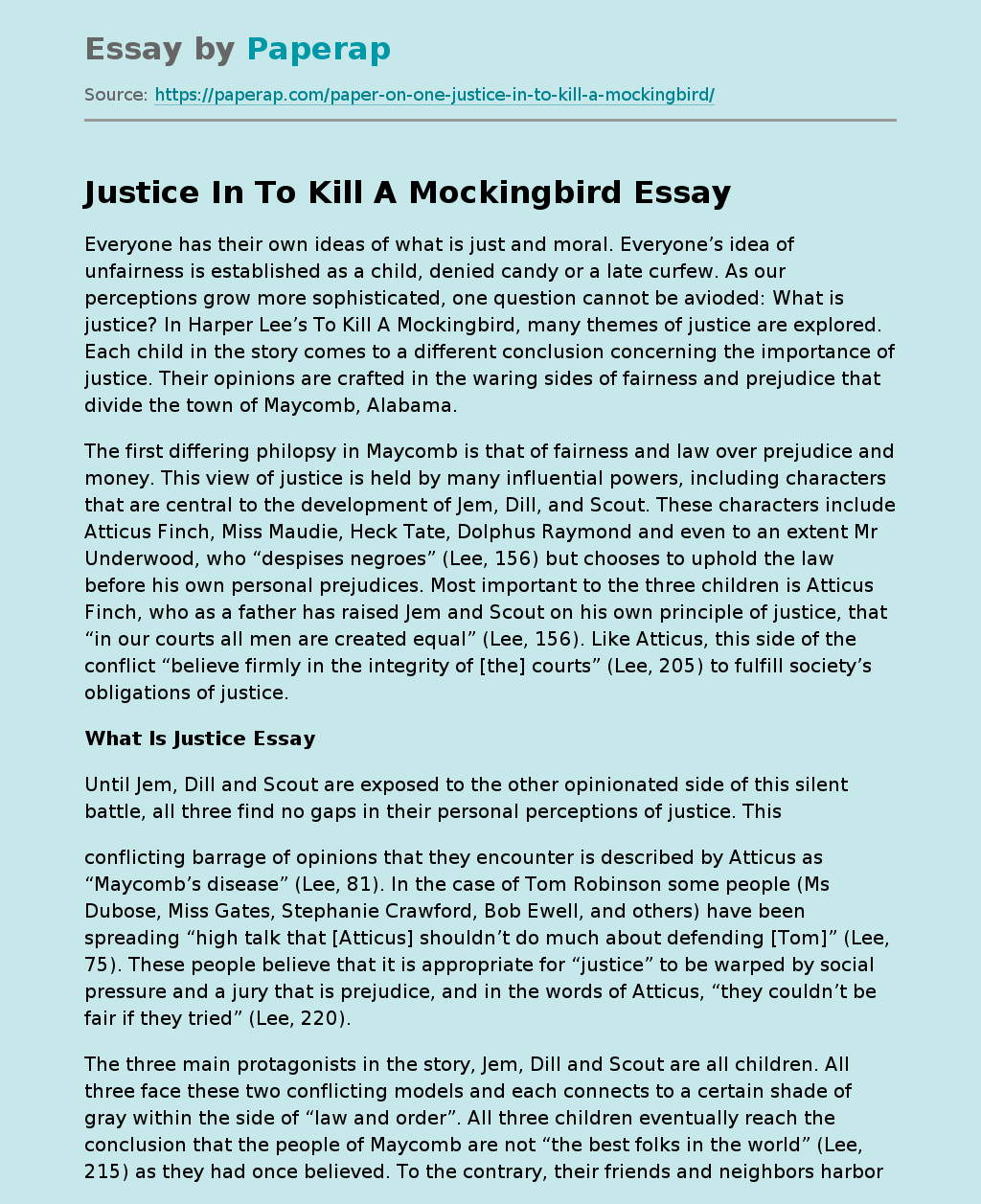Justice In To Kill A Mockingbird
Everyone has their own ideas of what is just and moral. Everyone’s idea of unfairness is established as a child, denied candy or a late curfew. As our perceptions grow more sophisticated, one question cannot be avioded: What is justice? In Harper Lee’s To Kill A Mockingbird, many themes of justice are explored. Each child in the story comes to a different conclusion concerning the importance of justice. Their opinions are crafted in the waring sides of fairness and prejudice that divide the town of Maycomb, Alabama.
The first differing philopsy in Maycomb is that of fairness and law over prejudice and money. This view of justice is held by many influential powers, including characters that are central to the development of Jem, Dill, and Scout. These characters include Atticus Finch, Miss Maudie, Heck Tate, Dolphus Raymond and even to an extent Mr Underwood, who “despises negroes” (Lee, 156) but chooses to uphold the law before his own personal prejudices.
Most important to the three children is Atticus Finch, who as a father has raised Jem and Scout on his own principle of justice, that “in our courts all men are created equal” (Lee, 156). Like Atticus, this side of the conflict “believe firmly in the integrity of [the] courts” (Lee, 205) to fulfill society’s obligations of justice.
What Is Justice Essay
Until Jem, Dill and Scout are exposed to the other opinionated side of this silent battle, all three find no gaps in their personal perceptions of justice. This
conflicting barrage of opinions that they encounter is described by Atticus as “Maycomb’s disease” (Lee, 81).
In the case of Tom Robinson some people (Ms Dubose, Miss Gates, Stephanie Crawford, Bob Ewell, and others) have been spreading “high talk that [Atticus] shouldn’t do much about defending [Tom]” (Lee, 75). These people believe that it is appropriate for “justice” to be warped by social pressure and a jury that is prejudice, and in the words of Atticus, “they couldn’t be fair if they tried” (Lee, 220).
The three main protagonists in the story, Jem, Dill and Scout are all children. All three face these two conflicting models and each connects to a certain shade of gray within the side of “law and order”. All three children eventually reach the conclusion that the people of Maycomb are not “the best folks in the world” (Lee, 215) as they had once believed. To the contrary, their friends and neighbors harbor deep imperfections which they discover “like somethin’ asleep wrapped up in a warm place” (Lee, 215). To clearly illustrate each child’s own discoveries and prospects on the idea of justice, each must be compared to another adult character in the novel.
The greatest influence on young Jem Finch is Atticus, a man whose faith in the court system is paramount to his beliefs. Jem aspires to be a lawyer, but is not resigned to the idea that biased juries are acceptable. Instead, he makes a promise to do something about “heathen juries […] soon as [he gets] grown” (Lee, 216). Like Atticus, Jem believes that ultimate justice is obtainable in the state’s judicial system.
Dill Harris shares a very different view of justice then his two best friends. His aptitude can be compared to Dolphus Raymond. Both characters have a cynical lack of faith when it comes to the people of Maycomb, represented by Dill’s statement, “there ain’t one thing in this world I can do about folks except laugh” (Lee, 216), and Raymond’s farce of being in “the clutches of whisky” (Lee, 200). Unlike Jem, Dill is unmotivated to work towards a world free of prejudice and is resigned to the idea.
Out of all three of the children in the story, Scout’s perception of justice is most difficult to divulge. While the reader is only able to hear Jem and Dill’s point of view when they decide to speak, all of Scout’s contemplations are offered. Scout’s initial view of justice is simplistic, her barbaric idea of revenge through fights is unchallenged. When Scout agrees with Heck Tate at the end of the novel and claims that forcing Arthur Radley to testify would be like “sort of like shootin’ a mocking bird” (Lee, 276), she makes an important designation between herself and her father. Heck Tate takes into account the circumstances of the events and fundamentally lies to protect Arthur. Scout sees this as acceptable, while Atticus is uneasy with the idea, claiming “nobody’s hushing this up. I don’t live that way” (Lee, 273). Scout’s ability as a child to take into account circumstance in her perception of justice makes her reasoning much more sophisticated then that of the court system.
In conclusion, it’s clear that all three children in To Kill A Mockingbird harbor their own individual perceptions of what “justice” really is, shaped by the many influential adults in their lives. Among many themes, To Kill A Mockingbird offers a microcosm of the ideals of justice in a multi-faceted society that influences all our perceptions, especially in childhood.
Justice In To Kill A Mockingbird. (2019, Dec 05). Retrieved from https://paperap.com/paper-on-one-justice-in-to-kill-a-mockingbird/

